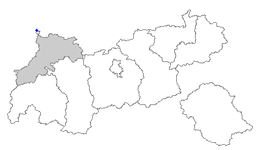Jungholz
Jungholz | |
|---|---|
 | |
 Location of Jungholz within Tyrol | |
| Coordinates: 47°34′25″N 10°26′50″E / 47.57361°N 10.44722°E | |
| Country | Austria |
| State | Tyrol |
| District | Reutte |
| Government | |
| • Mayor | Karina Konrad |
| Area | |
| • Total | 7.06 km2 (2.73 sq mi) |
| Elevation | 1,054 m (3,458 ft) |
| Population (2018-01-01)[2] | |
| • Total | 301 |
| • Density | 43/km2 (110/sq mi) |
| Time zone | UTC+1 (CET) |
| • Summer (DST) | UTC+2 (CEST) |
| Postal code | |
| Area code | 05676 |
| Vehicle registration | RE |
| Website | www |
Jungholz (German pronunciation: [ˈjʊŋhɔlt͡s] ) is a village in the district of Reutte in the Austrian state of Tyrol that is only accessible via Germany. The lack of a road connection to anywhere else in Austria led to Jungholz being included in the German customs area before Austria joined the EU in 1995. It also used the Deutsche Mark instead of the Austrian schilling as currency until 2002, when the euro took over. Letters to Jungholz can be addressed with either a German or an Austrian postal code.
Quadripoint
[edit]
Jungholz forms a pene-exclave of Austria that is connected to the rest of Austria by a single point, which is the summit of the mountain Sorgschrofen (1,636 m, 5,367 ft). As well as housing border post number 110 on the normal international border between Tyrol and Bavaria, a second border starts and, having gone round Jungholz, ends there. There are thus borders extending in four directions from the summit, called a quadripoint. Two Austrian (Tyrolean, Reutte) and two German (Bavarian, Oberallgäu) municipalities meet at that point, starting with Jungholz and continuing clockwise:
- Jungholz (Austrian, north)
- Pfronten (German, east)
- Schattwald (Austrian, south)
- Bad Hindelang (German, west)
History
[edit]On 24 June 1342, Hermann Häselin, a farmer from Wertach in Germany, sold the area to Heinz Lochpyler, an Austrian taxman from nearby Tannheim.[3] The buyer had the area incorporated with his other possession of Tyrol. In the Bavarian–Austrian border treaty of 1844 Jungholz went to Austria.[citation needed] Its customs union with Germany dates to a Treaty signed in 1868.[4]
In 1938 following the German takeover of Austria, Jungholz and the similarly isolated Kleinwalsertal were annexed to Gau Swabia in Bavaria, though returned to Austria after the end of WWII.[5]
See also
[edit]References
[edit]- ^ "Dauersiedlungsraum der Gemeinden Politischen Bezirke und Bundesländer - Gebietsstand 1.1.2018". Statistics Austria. Retrieved 10 March 2019.
- ^ "Einwohnerzahl 1.1.2018 nach Gemeinden mit Status, Gebietsstand 1.1.2018". Statistics Austria. Retrieved 9 March 2019.
- ^ MacEacheran, Mike (14 February 2022). "Jungholz: A ski town stuck in the wrong nation". BBC. Retrieved 14 February 2022.
- ^ "Regulation (EEC) No 1496/68 of the Council of 27 September 1968 on the definition of the customs territory of the Community". op.europa.eu. Publications Office of the European Union. Retrieved 21 August 2021.
- ^ Jahrhundert – Rückblick (in German) Kleinwalsertal website
External links
[edit]- Jungholz's official website (in German only)


